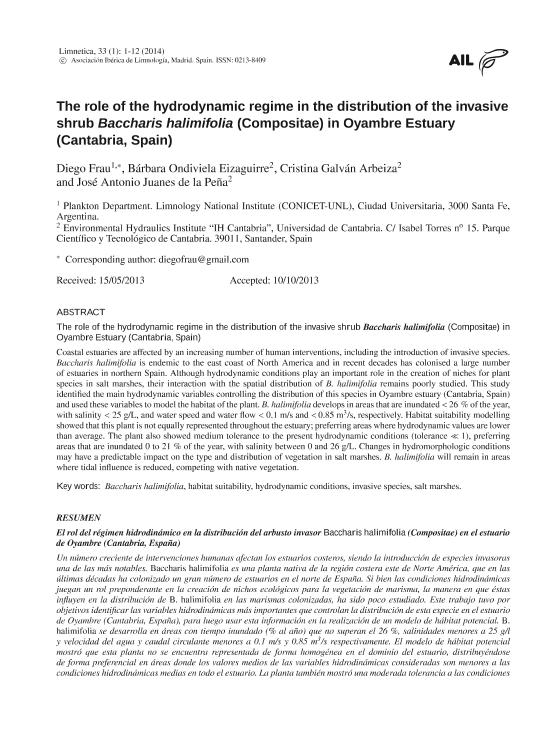Mostrar el registro sencillo del ítem
dc.contributor.author
Frau, Diego

dc.contributor.author
Ondiviela Eizaguirre, Bárbara
dc.contributor.author
Galván Arbeiza, Cristina
dc.contributor.author
Juanes de la Peña, José Antonio
dc.date.available
2019-11-26T01:10:07Z
dc.date.issued
2014-10
dc.identifier.citation
Frau, Diego; Ondiviela Eizaguirre, Bárbara; Galván Arbeiza, Cristina; Juanes de la Peña, José Antonio; The role of the hydrodinamic regime in the distribution of the invasive shrub Baccharis halimifolia (Compositae) in Oyambre Estuary (Cantabria, Spain); Asociación Española de Limnología; Limnetica; 33; 10-2014; 1-12
dc.identifier.issn
0213-8409
dc.identifier.uri
http://hdl.handle.net/11336/90441
dc.description.abstract
Coastal estuaries are affected by an increasing number of human interventions, including the introduction of invasive species. Baccharis halimifolia is endemic to the east coast of North America and in recent decades has colonised a large number of estuaries in northern Spain. Although hydrodynamic conditions play an important role in the creation of niches for plant species in salt marshes, their interaction with the spatial distribution of B. halimifolia remains poorly studied. This study identified the main hydrodynamic variables controlling the distribution of this species in Oyambre estuary (Cantabria, Spain) and used these variables to model the habitat of the plant. B. halimifolia develops in areas that are inundated < 26 %of the year, with salinity < 25 g/L, and water speed and water flow < 0.1 m/s and < 0.85 m3/s, respectively. Habitat suitability modelling showed that this plant is not equally represented throughout the estuary; preferring areas where hydrodynamic values are lower than average. The plant also showed medium tolerance to the present hydrodynamic conditions (tolerance ≪ 1), preferring areas that are inundated 0 to 21 % of the year, with salinity between 0 and 26 g/L. Changes in hydromorphologic conditions may have a predictable impact on the type and distribution of vegetation in salt marshes. B. halimifolia will remain in areas where tidal influence is reduced, competing with native vegetation.
dc.format
application/pdf
dc.language.iso
eng
dc.publisher
Asociación Española de Limnología

dc.rights
info:eu-repo/semantics/openAccess
dc.rights.uri
https://creativecommons.org/licenses/by-nc-sa/2.5/ar/
dc.subject
BACHARIS HALIMIFOLIA
dc.subject
HABITAT SUITABILITY
dc.subject
HYDRODINAMIC CONDITIONS
dc.subject
INVASIVE SPECIES
dc.subject.classification
Ecología

dc.subject.classification
Ciencias Biológicas

dc.subject.classification
CIENCIAS NATURALES Y EXACTAS

dc.title
The role of the hydrodinamic regime in the distribution of the invasive shrub Baccharis halimifolia (Compositae) in Oyambre Estuary (Cantabria, Spain)
dc.type
info:eu-repo/semantics/article
dc.type
info:ar-repo/semantics/artículo
dc.type
info:eu-repo/semantics/publishedVersion
dc.date.updated
2019-11-25T17:12:23Z
dc.journal.volume
33
dc.journal.pagination
1-12
dc.journal.pais
España

dc.journal.ciudad
Barcelona
dc.description.fil
Fil: Frau, Diego. Consejo Nacional de Investigaciones Científicas y Técnicas. Centro Científico Tecnológico Conicet - Santa Fe. Instituto Nacional de Limnología. Universidad Nacional del Litoral. Instituto Nacional de Limnología; Argentina
dc.description.fil
Fil: Ondiviela Eizaguirre, Bárbara. Instituto de Hidráulica Ambiental "ih Cantabria"; España
dc.description.fil
Fil: Galván Arbeiza, Cristina. Instituto de Hidráulica Ambiental "ih Cantabria"; España. Universidad de Cantabria; España
dc.description.fil
Fil: Juanes de la Peña, José Antonio. Universidad de Cantabria; España. Instituto de Hidráulica Ambiental "ih Cantabria"; España
dc.journal.title
Limnetica

Archivos asociados
